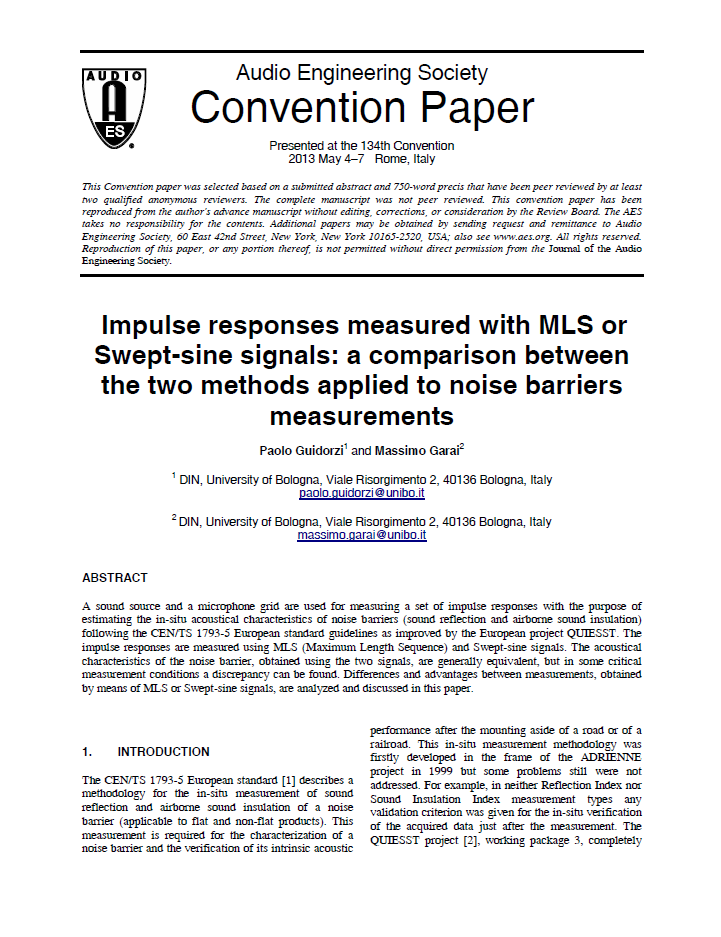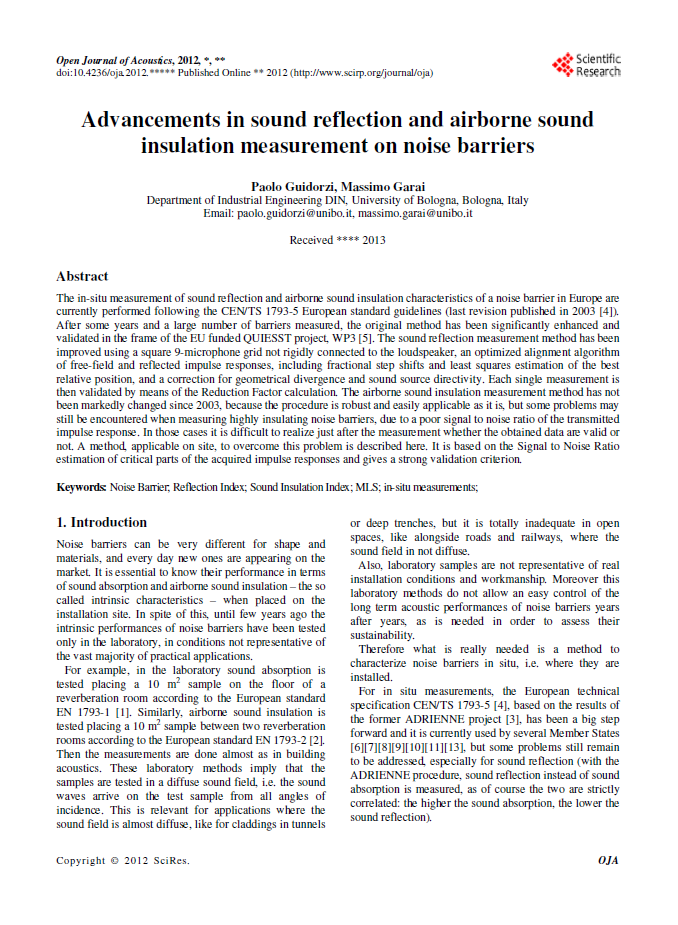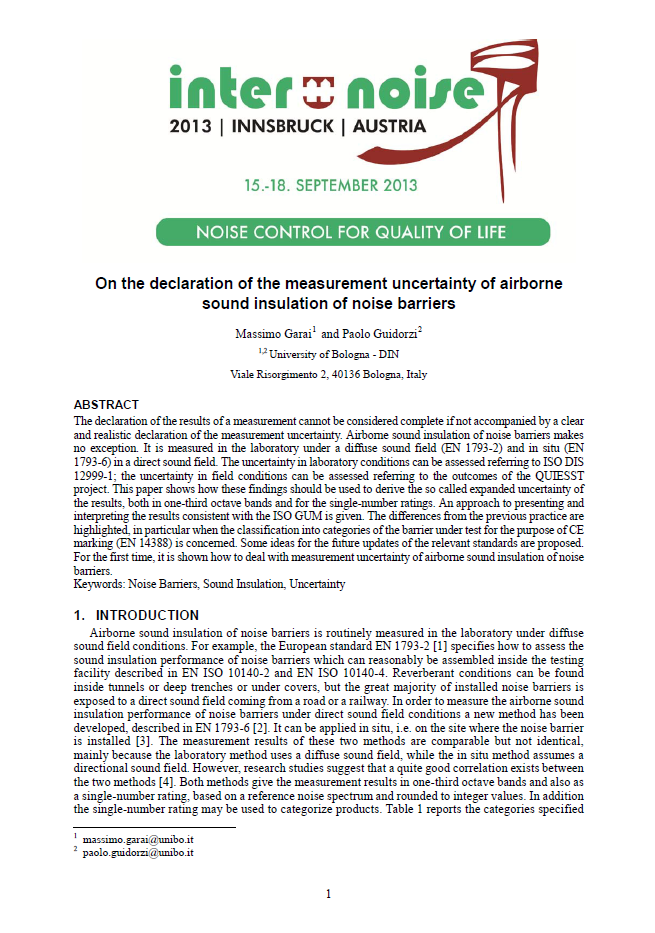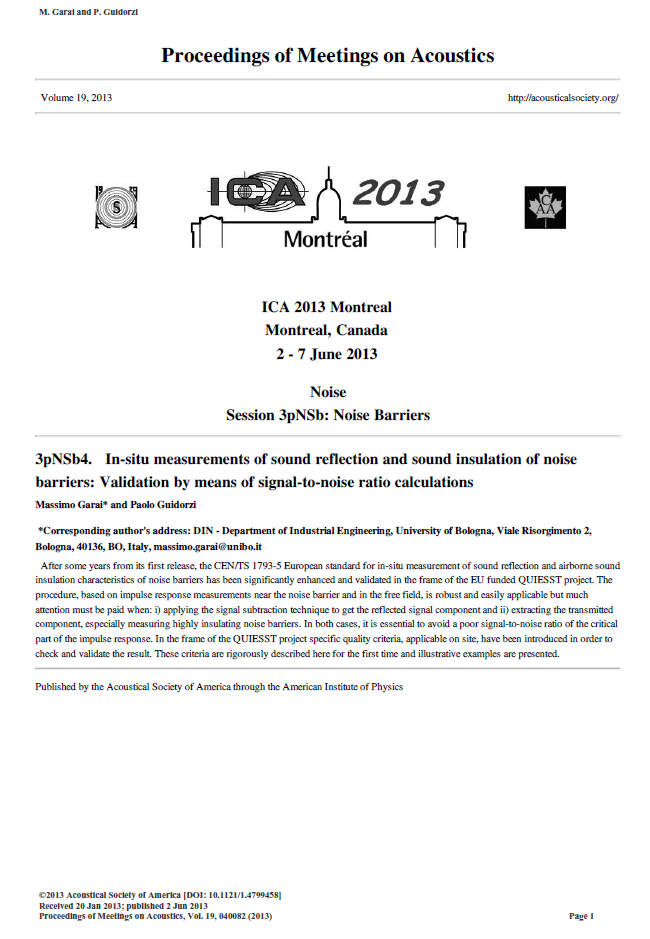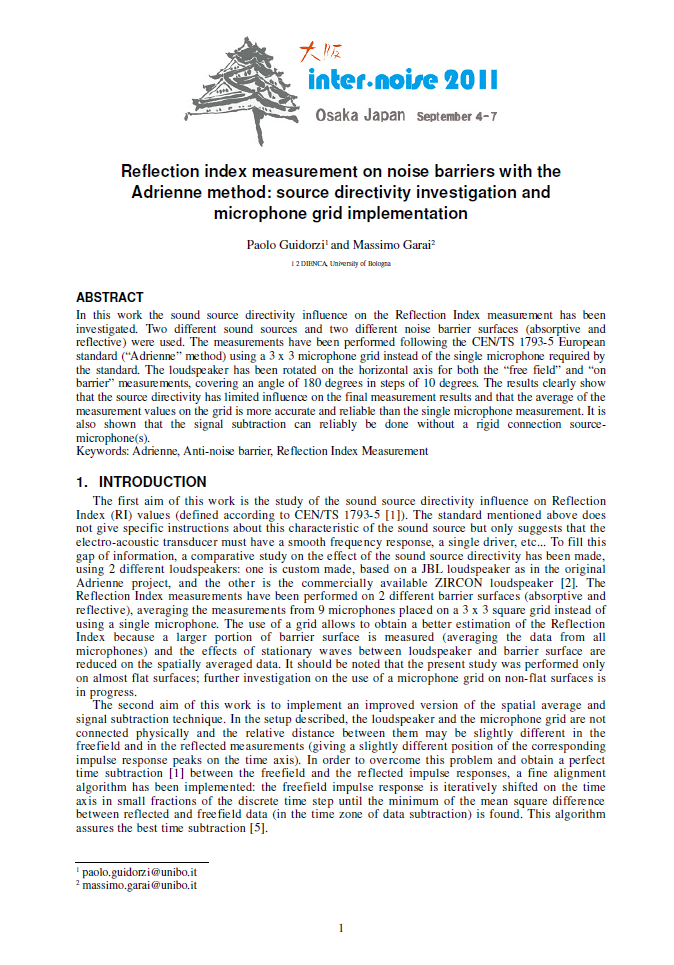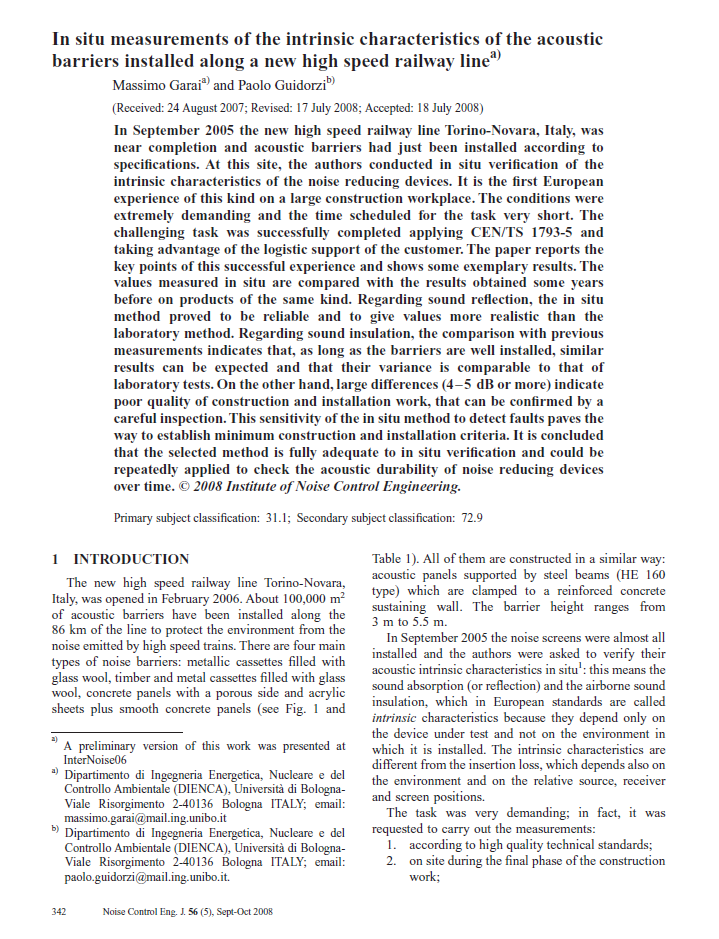| |
Noise Barrier Measurements
Selected Papers
| P. Guidorzi, M. Garai, “Advancements in sound reflection and airborne sound insulation measurement on noise barriers”, Open Journal of Acoustics, 33(2A), 25-38, (2013). ISSN: 2162-5786, ISSN Online: 2162-5794, DOI: 10.4236/oja.2013.32A004 ABSTRACT The in-situ measurement of sound reflection and airborne sound insulation characteristics of a noise barrier in Europe are currently performed following the CEN/TS 1793-5 European standard guidelines (last revision published in 2003). After some years and a large number of barriers measured, the original method has been significantly enhanced and validated in the frame of the EU funded QUIESST project, WP3. The sound reflection measurement method has been improved using a square 9-microphone grid not rigidly connected to the loudspeaker, an optimized alignment algorithm of free-field and reflected impulse responses, including fractional step shifts and least squares estimation of the best relative position, and a correction for geometrical divergence and sound source directivity. Each single measurement is then validated by means of the Reduction Factor calculation. The airborne sound insulation measurement method has not been markedly changed since 2003, because the procedure is robust and easily applicable as it is, but some problems may still be encountered when measuring highly insulating noise barriers, due to a poor signal to noise ratio of the transmitted impulse response. In those cases it is difficult to realize just after the measurement whether the obtained data are valid or not. A method, applicable on site, to overcome this problem is described here. It is based on the Signal to Noise Ratio estimation of critical parts of the acquired impulse responses and gives a strong validation criterion. |
|
| M. Garai, P. Guidorzi, “On the declaration of the measurement uncertainty of airborne sound insulation of noise barriers” (invited paper), Proc. Inter-Noise 2013, Innsbruck, Austria, ISSN 0736-2935, Paper 94, 1-10 (2013) The declaration of the results of a measurement cannot be considered complete if not accompanied by a clear and realistic declaration of the measurement uncertainty. Airborne sound insulation of noise barriers makes no exception. It is measured in the laboratory under a diffuse sound field (EN 1793-2) and in situ (EN 1793-6) in a direct sound field. The uncertainty in laboratory conditions can be assessed referring to ISO DIS 12999-1; the uncertainty in field conditions can be assessed referring to the outcomes of the QUIESST project. This paper shows how these findings should be used to derive the so called expanded uncertainty of the results, both in one-third octave bands and for the single-number ratings. An approach to presenting and interpreting the results consistent with the ISO GUM is given. The differences from the previous practice are highlighted, in particular when the classification into categories of the barrier under test for the purpose of CE marking (EN 14388) is concerned. Some ideas for the future updates of the relevant standards are proposed. For the first time, it is shown how to deal with measurement uncertainty of airborne sound insulation of noise barriers. |
|
| P. Guidorzi, M. Garai, “Impulse responses measured with MLS or Swept-sine signals: a comparison between the two methods applied to noise barriers measurements”, Proc. AES Convention, Roma, Italy, ISBN 978-0-937803-91-2, Paper ID 8914, 1-10 (2013) ABSTRACT A sound source and a microphone grid are used for measuring a set of impulse responses with the purpose of estimating the in-situ acoustical characteristics of noise barriers (sound reflection and airborne sound insulation) following the CEN/TS 1793-5 European standard guidelines as improved by the European project QUIESST. The impulse responses are measured using MLS (Maximum Length Sequence) and Swept-sine signals. The acoustical characteristics of the noise barrier, obtained using the two signals, are generally equivalent, but in some critical measurement conditions a discrepancy can be found. Differences and advantages between measurements, obtained by means of MLS or Swept-sine signals, are analyzed and discussed in this paper. |
|
| M. Garai, P. Guidorzi, “In-situ measurements of sound reflection and sound insulation of noise barriers: validation by means of signal-to-noise ratio calculations”, Proc. 21' ICA 2013, Montréal, Canada, Paper ID 040082_1, 1-9 (2013) and J. Acoust. Soc. Am., ISSN 0001-4966, 133(5-2), 3451 (2013) ABSTRACT After some years from its first release, the CEN/TS 1793-5 European standard for in-situ measurement of sound reflection and airborne sound insulation characteristics of noise barriers has been significantly enhanced and validated in the frame of the EU funded QUIESST project. The procedure, based on impulse response measurements near the noise barrier and in the free field, is robust and easily applicable but much attention must be paid when: i) applying the signal subtraction technique to get the reflected signal component and ii) extracting the transmitted component, especially measuring highly insulating noise barriers. In both cases, it is essential to avoid a poor signal-to-noise ratio of the critical part of the impulse response. In the frame of the QUIESST project specific quality criteria, applicable on site, have been introduced in order to check and validate the result. These criteria are rigorously described here for the first time and illustrative examples are presented. |
|
| M. Garai, P. Guidorzi, “Reflection index measurement on noise barriers with the Adrienne method: source directivity investigation and microphone grid implementation” (invited paper), Proc. Inter-Noise 2011, Osaka, Japan, Paper 427100, 1-6 (2011) ABSTRACT In this work the sound source directivity influence on the Reflection Index measurement has been investigated. Two different sound sources and two different noise barrier surfaces (absorptive and reflective) were used. The measurements have been performed following the CEN/TS 1793-5 European standard (“Adrienne” method) using a 3 x 3 microphone grid instead of the single microphone required by the standard. The loudspeaker has been rotated on the horizontal axis for both the free field and on barrier measurements, covering an angle of 180 degrees in steps of 10 degrees. The results clearly show that the source directivity has limited influence on the final measurement results and that the average of the measurement values on the grid is more accurate and reliable than the single microphone measurement. It is also shown that the signal subtraction can reliably be done without a rigid connection source-microphone(s). |
|
| M.Garai, P.Guidorzi, "In situ measurements of the intrinsic characteristics of the acoustic barriers installed along a new high speed railway line", Noise Control Eng. J., 56(5), 342-355 (2008) ABSTRACT In September 2005 the new high speed railway line Torino-Novara, Italy, was near completion and acoustic barriers had just been installed according to specifications. At this site, the authors conducted in situ verification of the intrinsic characteristics of the noise reducing devices. It is the first European experience of this kind on a large construction workplace. The conditions were extremely demanding and the time scheduled for the task very short. The challenging task was successfully completed applying CEN/TS 1793-5 and taking advantage of the logistic support of the customer. The paper reports the key points of this successful experience and shows some exemplary results. The values measured in situ are compared with the results obtained some years before on products of the same kind. Regarding sound reflection, the in situ method proved to be reliable and to give values more realistic than the laboratory method. Regarding sound insulation, the comparison with previous measurements indicates that, as long as the barriers are well installed, similar results can be expected and that their variance is comparable to that of laboratory tests. On the other hand, large differences (4-5 dB or more) indicate poor quality of construction and installation work, that can be confirmed by a careful inspection. This sensitivity of the in situ method to detect faults paves the way to establish minimum construction and installation criteria. It is concluded that the selected method is fully adequate to in situ verification and could be repeatedly applied to check the acoustic durability of noise reducing devices over time. |
|

Questo sito non utilizza cookies. Componenti di terze parti potrebbero utilizzarli. Per maggiori informazioni clicca qui
Selected papers
Noise Barrier Measurements
